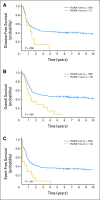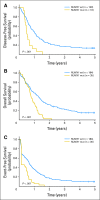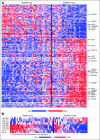RUNX1 mutations are associated with poor outcome in younger and older patients with cytogenetically normal acute myeloid leukemia and with distinct gene and MicroRNA expression signatures
- PMID: 22753902
- PMCID: PMC3732007
- DOI: 10.1200/JCO.2011.40.6652
RUNX1 mutations are associated with poor outcome in younger and older patients with cytogenetically normal acute myeloid leukemia and with distinct gene and MicroRNA expression signatures
Abstract
Purpose: To determine the association of RUNX1 mutations with therapeutic outcome in younger and older patients with primary cytogenetically normal acute myeloid leukemia (CN-AML) and with gene/microRNA expression signatures.
Patients and methods: Younger (< 60 years; n = 175) and older (≥ 60 years; n = 225) patients with CN-AML treated with intensive cytarabine/anthracycline-based first-line therapy on Cancer and Leukemia Group B protocols were centrally analyzed for RUNX1 mutations by polymerase chain reaction and direct sequencing and for established prognostic gene mutations. Gene/microRNA expression profiles were derived using microarrays.
Results: RUNX1 mutations were found in 8% and 16% of younger and older patients, respectively (P = .02). They were associated with ASXL1 mutations (P < .001) and inversely associated with NPM1 (P < .001) and CEBPA (P = .06) mutations. RUNX1-mutated patients had lower complete remission rates (P = .005 in younger; P = .006 in older) and shorter disease-free survival (P = .058 in younger; P < .001 in older), overall survival (P = .003 in younger; P < .001 in older), and event-free survival (P < .001 for younger and older) than RUNX1 wild-type patients. Because RUNX1 mutations were more common in older patients and almost never coexisted with NPM1 mutations, RUNX1 mutation-associated expression signatures were derived in older, NPM1 wild-type patients and featured upregulation of genes normally expressed in primitive hematopoietic cells and B-cell progenitors, including DNTT, BAALC, BLNK, CD109, RBPMS, and FLT3, and downregulation of promoters of myelopoiesis, including CEBPA and miR-223.
Conclusion: RUNX1 mutations are twice as common in older than younger patients with CN-AML and negatively impact outcome in both age groups. RUNX1-mutated blasts have molecular features of primitive hematopoietic and lymphoid progenitors, potentially leading to novel therapeutic approaches.
Figures



Similar articles
-
TET2 mutations improve the new European LeukemiaNet risk classification of acute myeloid leukemia: a Cancer and Leukemia Group B study.J Clin Oncol. 2011 Apr 1;29(10):1373-81. doi: 10.1200/JCO.2010.32.7742. Epub 2011 Feb 22. J Clin Oncol. 2011. PMID: 21343549 Free PMC article. Clinical Trial.
-
RUNX1 mutations in acute myeloid leukemia: results from a comprehensive genetic and clinical analysis from the AML study group.J Clin Oncol. 2011 Apr 1;29(10):1364-72. doi: 10.1200/JCO.2010.30.7926. Epub 2011 Feb 22. J Clin Oncol. 2011. PMID: 21343560 Clinical Trial.
-
IDH1 and IDH2 gene mutations identify novel molecular subsets within de novo cytogenetically normal acute myeloid leukemia: a Cancer and Leukemia Group B study.J Clin Oncol. 2010 May 10;28(14):2348-55. doi: 10.1200/JCO.2009.27.3730. Epub 2010 Apr 5. J Clin Oncol. 2010. PMID: 20368543 Free PMC article.
-
Prognostic significance of FLT3 internal tandem duplication, nucleophosmin 1, and CEBPA gene mutations for acute myeloid leukemia patients with normal karyotype and younger than 60 years: a systematic review and meta-analysis.Ann Hematol. 2014 Aug;93(8):1279-86. doi: 10.1007/s00277-014-2072-6. Epub 2014 May 7. Ann Hematol. 2014. PMID: 24801015 Review.
-
Targeting RUNX1 in acute myeloid leukemia: preclinical innovations and therapeutic implications.Expert Opin Ther Targets. 2021 Apr;25(4):299-309. doi: 10.1080/14728222.2021.1915991. Epub 2021 Apr 28. Expert Opin Ther Targets. 2021. PMID: 33906574 Review.
Cited by
-
Mitogen-activated protein kinase binding protein 1 (MAPKBP1) is an unfavorable prognostic biomarker in cytogenetically normal acute myeloid leukemia.Oncotarget. 2015 Apr 10;6(10):8144-54. doi: 10.18632/oncotarget.3519. Oncotarget. 2015. PMID: 25924238 Free PMC article.
-
Pediatric Germline Predisposition to Myeloid Neoplasms.Curr Hematol Malig Rep. 2022 Dec;17(6):266-274. doi: 10.1007/s11899-022-00681-5. Epub 2022 Sep 19. Curr Hematol Malig Rep. 2022. PMID: 36117229 Review.
-
Multiple Roles of the RUNX Gene Family in Hepatocellular Carcinoma and Their Potential Clinical Implications.Cells. 2023 Sep 19;12(18):2303. doi: 10.3390/cells12182303. Cells. 2023. PMID: 37759525 Free PMC article. Review.
-
Prognostic and Biologic Relevance of Clinically Applicable Long Noncoding RNA Profiling in Older Patients with Cytogenetically Normal Acute Myeloid Leukemia.Mol Cancer Ther. 2019 Aug;18(8):1451-1459. doi: 10.1158/1535-7163.MCT-18-1125. Epub 2019 Jun 4. Mol Cancer Ther. 2019. PMID: 31164409 Free PMC article.
-
Mutations in AML: prognostic and therapeutic implications.Hematology Am Soc Hematol Educ Program. 2016 Dec 2;2016(1):348-355. doi: 10.1182/asheducation-2016.1.348. Hematology Am Soc Hematol Educ Program. 2016. PMID: 27913501 Free PMC article. Review.
References
-
- Gaidzik V, Döhner K. Prognostic implications of gene mutations in acute myeloid leukemia with normal cytogenetics. Semin Oncol. 2008;35:346–355. - PubMed
-
- Mrózek K, Heerema NA, Bloomfield CD. Cytogenetics in acute leukemia. Blood Rev. 2004;18:115–136. - PubMed
-
- Thiede C, Steudel C, Mohr B, et al. Analysis of FLT3-activating mutations in 979 patients with acute myelogenous leukemia: Association with FAB subtypes and identification of subgroups with poor prognosis. Blood. 2002;99:4326–4335. - PubMed
-
- Whitman SP, Archer KJ, Feng L, et al. Absence of the wild-type allele predicts poor prognosis in adult de novo acute myeloid leukemia with normal cytogenetics and the internal tandem duplication of FLT3: A Cancer and Leukemia Group B study. Cancer Res. 2001;61:7233–7239. - PubMed
Publication types
MeSH terms
Substances
Grants and funding
- U10 CA033601/CA/NCI NIH HHS/United States
- U24 CA114725/CA/NCI NIH HHS/United States
- U10 CA101140/CA/NCI NIH HHS/United States
- P30 CA016058/CA/NCI NIH HHS/United States
- CA77658/CA/NCI NIH HHS/United States
- CA31946/CA/NCI NIH HHS/United States
- CA140158/CA/NCI NIH HHS/United States
- CA33601/CA/NCI NIH HHS/United States
- P50 CA140158/CA/NCI NIH HHS/United States
- CA16058/CA/NCI NIH HHS/United States
- CA101140/CA/NCI NIH HHS/United States
- U10 CA077658/CA/NCI NIH HHS/United States
- U10 CA031946/CA/NCI NIH HHS/United States
- R21 CA129657/CA/NCI NIH HHS/United States
- CA129657/CA/NCI NIH HHS/United States
- CA114725/CA/NCI NIH HHS/United States
LinkOut - more resources
Full Text Sources
Other Literature Sources
Medical
Miscellaneous

